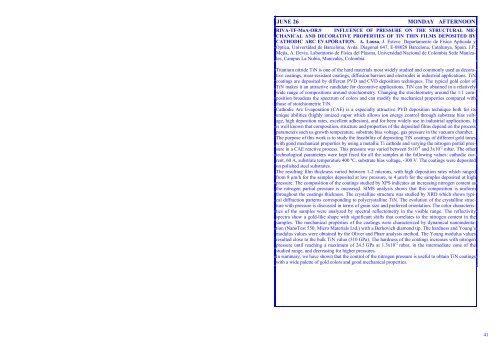Wüest M. 51 Wykes M. 82 Yamaguchi M. 17 Ybarra G. 129 Yubero F ...
Wüest M. 51 Wykes M. 82 Yamaguchi M. 17 Ybarra G. 129 Yubero F ...
Wüest M. 51 Wykes M. 82 Yamaguchi M. 17 Ybarra G. 129 Yubero F ...
Create successful ePaper yourself
Turn your PDF publications into a flip-book with our unique Google optimized e-Paper software.
JUNE 26 MONDAY AFTERNOON<br />
RIVA-TF-MoA-OR.9 INFLUENCE OF PRESSURE ON THE STRUCTURAL ME-<br />
CHANICAL AND DECORATIVE PROPERTIES OF TiN THIN FILMS DEPOSITED BY<br />
CATHODIC ARC EVAPORATION. A. Lousa, J. Esteve. Departamento de Física Aplicada y<br />
Óptica, Universidad de Barcelona, Avda. Diagonal 647, E-08028 Barcelona, Catalunya, Spain. J.P.<br />
Mejia, A. Devia. Laboratorio de Física del Plasma, Universidad Nacional de Colombia Sede Manizales,<br />
Campus La Nubia, Manizales, Colombia.<br />
Titanium nitride TiN is one of the hard materials most widely studied and commonly used as decorative<br />
coatings, wear-resistant coatings, diffusion barriers and electrodes in industrial applications. TiN<br />
coatings are deposited by different PVD and CVD deposition techniques. The typical gold color of<br />
TiN makes it an attractive candidate for decorative applications. TiN can be obtained in a relatively<br />
wide range of compositions around stoichiometry. Changing the stoichiometry around the 1:1 composition<br />
broadens the spectrum of colors and can modify the mechanical properties compared with<br />
those of stoichiometric TiN.<br />
Cathodic Arc Evaporation (CAE) is a especially attractive PVD deposition technique both for its<br />
unique abilities (highly ionized vapor which allows ion energy control through substrate bias voltage,<br />
high deposition rates, excellent adhesion), and for been widely use in industrial applications. It<br />
is well known that composition, structure and properties of the deposited films depend on the process<br />
parameters such us growth temperature, substrate bias voltage, gas pressure in the vacuum chamber.<br />
The purpose of this work is to study the feasibility of depositing TiN coatings of different gold tones<br />
with good mechanical properties by using a metallic Ti cathode and varying the nitrogen partial pressure<br />
in a CAE reactive process. This pressure was varied between 5x10 -4 and 3x10 -2 mbar. The other<br />
technological parameters were kept fixed for all the samples at the following values: cathodic current,<br />
60 A, substrate temperature 400 ºC, substrate bias voltage, -300 V. The coatings were deposited<br />
on polished steel substrates.<br />
The resulting film thickness varied between 1-2 microns, with high deposition rates which ranged<br />
from 8 μm/h for the samples deposited at low pressure, to 4 μm/h for the samples deposited at high<br />
pressure. The composition of the coatings studied by XPS indicates an increasing nitrogen content as<br />
the nitrogen partial pressure is increased. SIMS analysis shows that this composition is uniform<br />
throughout the coatings thickness. The crystalline structure was studied by XRD which shows typical<br />
diffraction patterns corresponding to polycrystalline TiN. The evolution of the crystalline structure<br />
with pressure is discussed in terms of grain size and preferred orientation. The color characteristics<br />
of the samples were analyzed by spectral reflectometry in the visible range. The reflectivity<br />
spectra show a gold-like shape with significant shifts that correlates to the nitrogen content in the<br />
samples. The mechanical properties of the coatings were characterized by dynamical nanoindentation<br />
(NanoTest 550, Micro Materials Ltd.) with a Berkovich diamond tip. The hardness and Young’s<br />
modulus values were obtained by the Oliver and Pharr analysis method. The Young modulus values<br />
resulted close to the bulk TiN value (310 GPa). The hardness of the coatings increases with nitrogen<br />
pressure until reaching a maximum of 24.5 GPa at 1.3x10 -2 mbar, in the intermediate zone of the<br />
studied range, and decreasing for higher pressures.<br />
In summary, we have shown that the control of the nitrogen pressure is useful to obtain TiN coatings<br />
with a wide palette of gold colors and good mechanical properties.<br />
41
















